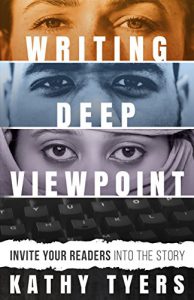 When it comes to captivating your audience, point of view (POV) matters. While there are no right or wrong places to use different POVs, there are absolutely genres and styles that work well with specific POVs. Before we jump into that, let’s look at the different POVs often used in fiction.
When it comes to captivating your audience, point of view (POV) matters. While there are no right or wrong places to use different POVs, there are absolutely genres and styles that work well with specific POVs. Before we jump into that, let’s look at the different POVs often used in fiction.
First, Third, and Omniscient POVs
For the sake of this post, we’ll refer to the three main POVs as First Person, Third Person, and Omniscient. Kathy Tyers, author of Writing Deep Viewpoint, defines them as:
- First Person: Narrator uses the “I” voice.
- Third Person: Narrator is present as a named character, using the “he” or “she” voice.
- Omniscient: Still “he” or “she,” the narrator’s consciousness is godlike in knowledge.
Each of these POVs provides s different depth of perspective.
First Person is the deepest, putting the reader directly into the mind and body of the narrator and allowing the reader to experience the story life as real life—only knowing, feeling, and sensing situations from one perspective.
Third Person can keep the reader close (Deep Third) or at a distance (Shallow Third). In today’s market, Deep Third is preferred. Similar to First Person, Deep Third pulls the reader into the mind and body of the narrator (again only showing what the character knows, feels, and senses), but the use of “he” and “she” pronouns adds a bit of space between the character and reader. Shallow Third adds even more space, as it doesn’t rely as heavily on the POV character’s thoughts, feelings, and emotions and often focuses more on external descriptions and plot points.
Omniscient is a third-person POV (as it uses “he” and “she”). Its perspective creates the most space between the characters and the reader as it doesn’t ever allow the reader to get into the main character’s head or heart. The narrator can describe what a character does (and possibly even the motivations) but can’t convey the feelings and emotions of each character because the narrator is, in fact, its own godlike, all-knowing character.
When and Why to Use Each POV
Technically, authors can use any POV in any novel or genre, but there are certain POVs that work better in different genres. Here are a few examples and why they do/don’t work.
First Person—Yes: This intimate perspective is excellent for books with one main character, such as young adult or women’s fiction novels that follow the growth and character arc of one person. There may be best friends, enemies, and love interests, but their main purpose in the story is to motivate the main character to change (or to highlight how the main character changes).
First Person—No: Most romance novel readers want to see the story from both the hero’s and the heroine’s perspectives. Because of this, the majority of romance novels are written in Third Person, so readers expect (and even demand) that perspective. While you technically can write a romance novel in First Person, there are readers who simply will not read it because of the POV. Since it’s possible to create a similar POV depth by writing Deep Third, that’s usually recommended for romance novels.
Third Person—Yes: Any book with multiple main characters is the perfect book for Third Person POV. I already mentioned romance novels, but it also works well in speculative fiction, historical, suspense, thriller. Anytime you have two or more main characters (characters with goals/motivations/conflicts and character arcs), it’s a good story for Third Person.
Third Person—No: I honestly can’t think of a time when I would encourage an author to avoid this POV. Because it’s so widely accepted, it can be used in just about any genre.
Omniscient—Yes: Omniscient works well in literary fiction, where the emphasis in on the theme instead of the plot and characters. It can also work well in epic novels, where the story takes place over large periods of time or space, again taking the focus off of a few specific characters and instead putting it on several people throughout time or across the world. (Think Hawaii by Jame Michener.)
Omniscient—No: Aside from one specific genre to avoid, it’s really a specific type of story that doesn’t work well with Omniscient: stories about or that highlight deep emotional connections. For that reason, romance novels are out. For all other genres … it depends. If you want to tell the story of six soldiers in the Civil War, omniscient might not be the best fit, but it could work perfectly for the story of a regimen of soldiers and their impact on the war.
I’ll say it one more time because it can’t be said enough—there are no right or wrong ways to use POV in your books. But there are ways to use POV to improve your chances of getting noticed, getting published, and developing a fan base.
Still have questions? Let me know! karin@karinbeery.com
For more fiction-writing tips and advice, follow me on Facebook at Writing Now Editing, or sign up for my monthly newsletter and learn the easiest way to make a good impression with agents and publishers!
For more fiction writing tips, try these:
Backstory: The Right and Wrong Ways to Use Dialogue
Why Novels Need Structure
